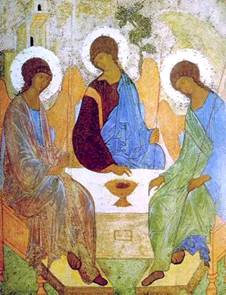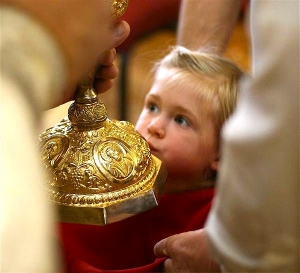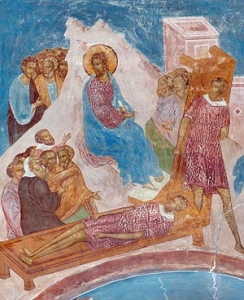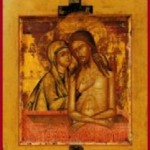What do you think about when you hear the word “GOD”? Maybe, it would help if we consider some of the Church’s teachings about God. First, let’s ask the basic question “What is God?” There are certain fundamental Orthodox teachings on this question. When we try to define God, we come to Mystery. Beginning with that question: The Church says “IS” – is beyond all human understanding, language, and abilities to grasp or describe.
God is Love; whoever sought to define Him would be like a blind person trying to count the grains of sand of the sea shore. – St. John Climakos
God is a God, who out of Love, reveals Himself to his creatures and creation. Our God is a Personal God. Our God is a TRINITARIAN GOD. What does this mean? The nature of God as Trinity is explained by a Father of the Church in this way:
[caption id="attachment_145" align="alignleft" width="226" caption="Holy Trinity"]

[/caption]
The Father is the origin of all, the Son realizes, and the Spirit fulfils.
Every thing subsists by the will of the Father, comes into being though the action of the Son, and reaches its perfection through the action of the Holy Spirit…
The number three therefore comes to your mind: the Lord who commands, The Word who creates, the Breath who confirms and what can it mean to confirm, if not to make perfect in holiness.
Treatise on the Holy Spirit – ST BASIL OF CAESARIA.
Think about the description of the nature of God, as we can understand him. Keep in mind; we can never understand the essence of God. Yet, all Three Persons of the Holy Trinity share the same essence (Nicene-Constantinopolitan Creed). They are unique persons; they are distinct but never separate. They have but one will, the will of the Father. NONE of three ever acts separately and apart from the other two. Metropolitan Kallistos Ware states, “They are not three Gods but one God.” What is it about God that we experience and know? We Orthodox view what and how we experience the Trinity in this way.
- GOD’S ESSENCE – WHAT “IS”, THE INNER BEING OF GOD, IS TOTALLY TRANSCENDENT. MAN CAN NEVER KNOW THE NATURE OF GOD AND GOD’S OTHERNESS. THIS IS BEYOND OUR ABILITY OR CAPACITY TO COMPREHEND.
- GOD’S ENERGY – GOD’S OPERATIONS OR ACTS OF POWER. THESE REVEAL GOD IN THE WORLD TO HIS CREATION. THIS IS CALLED GRACE, LIFE AND POWER AND IT FILLS ALL THINGS.
God is love (1 John, 8). The Persons of the Holy Trinity relate to one and another in a bond of LOVE, a perfect outpouring of selfless communion that is continuous, constant and mysterious. This is the nature of the relationship of the life of God as Trinity. Our destiny is to share this love and to express it in our lives. When we talk about God, we mean the Holy Trinity; and when we will speak of Christ, the second person of the Trinity, we speak of the Son of God revealed and encountered in the created world. In Christ, empowered by God’s Holy Spirit and through our Baptism and Chrismation, we have the potential to partake in the nature of God as Trinity (2 Peter 1, 3).
For Orthodox, the true image of God and the true nature of man are revealed in history by one event. God has revealed Himself to us in Christ. Through the Holy Spirit and the Virgin Mary, the Theotokos, Christ accomplishes this by His Incarnation in the Flesh. The Incarnation of our Savior, the Lord Jesus Christ, reveals the image of the Father to the world and only through Him, in the Holy Spirit, can we KNOW God the Father (St. John 17, 25-26). The hymn of Christmas, by St. Romanos the Melodist, summarizes the theology of incarnation with this phrase, “A new born child; God before the Ages”.
The Incarnation is an act of GOD out of love. It is an act of God identifying with our nature and of sharing His Nature with us. The nature of God as Trinity was the topic of the first two Ecumenical Councils; the next five great Councils dealt with who is Jesus and what is His relationship to us, His creation.
- JESUS CHRIST IS FULLY AND COMPLETELY PERFECT GOD.

- JESUS CHRIST IS FULLY AND COMPLETELY PERFECT HUMAN.
- JESUS CHRIST IS NOT TWO PERSONS BUT ONE.
- JESUS CHRIST IN HIS HUMANITY IS LIKE US IN EVERY WAY, SAVE HE IS WITHOUT SIN.
Earlier we said, the Godhead is a perfect community of love shared between the THREE Persons of the Trinity. The Incarnation is also about sharing and participation. Christ shares our humanity, even to death on the cross. This act of perfect Love enables us, in Christ, through His Spirit to participate in the life of God. We are called to intimate communion, even friendship with our Lord. The entire history of Christ in the world can be summed up in one word ENCOUNTER. Through Him, in Him and with Him, we encounter the Living God. Christ assumed our human nature and our human body. He transformed them with the Glory of God and showed us the true original beauty of our created potential. He presents it to His Father, wholly transfigured, so that we might share in the Nature of God.
This is the reason why the Word of God was made flesh, and the Son of God became the Son of Man: so that we could enter into communion with the Word of God and by receiving adoption might become the Sons of God. Indeed, we should not be able to share in immortality without a close union with the Immortal.
St. Ireneaus of Lyons
In Christ, we are called to KNOW the Father. This knowledge is the prayer of Christ before his crucifixion. His Resurrection abolished the hold which death had on us since our fall. His Accession granted us an intercessor at the Throne of God. At Pentecost, He asks the Father to send His Spirit to continue His Presence among us. His Second Coming will give the righteous immortality and perfect communion with God. These words of prayer explain our relationship to God the Holy Trinity.
My hope is the Father,
My refuge is the Son,
My Protection is the Holy Spirit,
O’ Holy Trinity – Glory to You.
St Ioannicios the Great
]]>


 Today, I would like to talk about silence. As I was growing up, my parents always referred to the Friday before the Saturday of Lazarus – as the “Silence (oi koufi)”. I always thought this was because the Akathist had finished and there wasn’t a service that night. Ok, there was silence. Now, I look at this a bit more deeply. If you remember a few years ago, there was this movement to help young people make better decisions by using the question, “What would Jesus do?” As I recall, there were even little rubber bracelets with the letters “WWJD” on them. In this case this is the question that should be asked. The Gospel reading of the Raising of Lazarus, (John 11, 1 – 45) begins with Jesus apparently hesitating to go to his friend’s aid. Well, this supposed hesitation had a real purpose, for all to see the glory of God. How was this to be accomplished? Our Lord seemingly was blasé about Lazarus’s illness and rushing to his side. After staying put for two days, Jesus prepared to go to Bethany informing His disciples that Lazarus was dead. As Jesus encountered Martha and Mary, they expressed thoughts that we all feel at sometime, “if only.” They were sure that if only Jesus had been there Lazarus wouldn’t have died, but Jesus was silent and missing. For us to truly understand Jesus’ hesitation, we need to know a bit about the Jewish teaching concerning death. At day four, in the Jewish understanding, the soul left the body in other words the body was a cadaver, a corpse. So if Lazarus was a corpse, Jesus did not simply resuscitate him. As Jesus called forth Lazarus and Lazarus walked out of his tomb Christ created life from dead matter. The Creator God bestowed life on Lazarus. Christ is God and the silence of Lazarus’ tomb was shattered. To the assembled crowd this silence was deafening.]]>
Today, I would like to talk about silence. As I was growing up, my parents always referred to the Friday before the Saturday of Lazarus – as the “Silence (oi koufi)”. I always thought this was because the Akathist had finished and there wasn’t a service that night. Ok, there was silence. Now, I look at this a bit more deeply. If you remember a few years ago, there was this movement to help young people make better decisions by using the question, “What would Jesus do?” As I recall, there were even little rubber bracelets with the letters “WWJD” on them. In this case this is the question that should be asked. The Gospel reading of the Raising of Lazarus, (John 11, 1 – 45) begins with Jesus apparently hesitating to go to his friend’s aid. Well, this supposed hesitation had a real purpose, for all to see the glory of God. How was this to be accomplished? Our Lord seemingly was blasé about Lazarus’s illness and rushing to his side. After staying put for two days, Jesus prepared to go to Bethany informing His disciples that Lazarus was dead. As Jesus encountered Martha and Mary, they expressed thoughts that we all feel at sometime, “if only.” They were sure that if only Jesus had been there Lazarus wouldn’t have died, but Jesus was silent and missing. For us to truly understand Jesus’ hesitation, we need to know a bit about the Jewish teaching concerning death. At day four, in the Jewish understanding, the soul left the body in other words the body was a cadaver, a corpse. So if Lazarus was a corpse, Jesus did not simply resuscitate him. As Jesus called forth Lazarus and Lazarus walked out of his tomb Christ created life from dead matter. The Creator God bestowed life on Lazarus. Christ is God and the silence of Lazarus’ tomb was shattered. To the assembled crowd this silence was deafening.]]>  [/caption]
[/caption]
 [/caption]
“Courage, Mother because you will see me first on my coming first from the tombs. I am coming to show you by how many toils I ransomed Adam and how much I sweated for his sake. I shall show it to my friends by showing the marks in my hands and then you will see Eve, Mother, living as before, and you will cry out with joy: ‘He has saved my forebears, my Son and my God.’*
*(St. Romanos the Melodist. On the Life of Christ: Kontakia. Translated by Archimandrite Ephrem Lash. Edited by Kerry Brown, The Sacred Literature Series. New York et al.: HarperCollins Publishers, 1995, p. 148).]]>
[/caption]
“Courage, Mother because you will see me first on my coming first from the tombs. I am coming to show you by how many toils I ransomed Adam and how much I sweated for his sake. I shall show it to my friends by showing the marks in my hands and then you will see Eve, Mother, living as before, and you will cry out with joy: ‘He has saved my forebears, my Son and my God.’*
*(St. Romanos the Melodist. On the Life of Christ: Kontakia. Translated by Archimandrite Ephrem Lash. Edited by Kerry Brown, The Sacred Literature Series. New York et al.: HarperCollins Publishers, 1995, p. 148).]]>
 [/caption]
The Father is the origin of all, the Son realizes, and the Spirit fulfils.
[/caption]
The Father is the origin of all, the Son realizes, and the Spirit fulfils. 